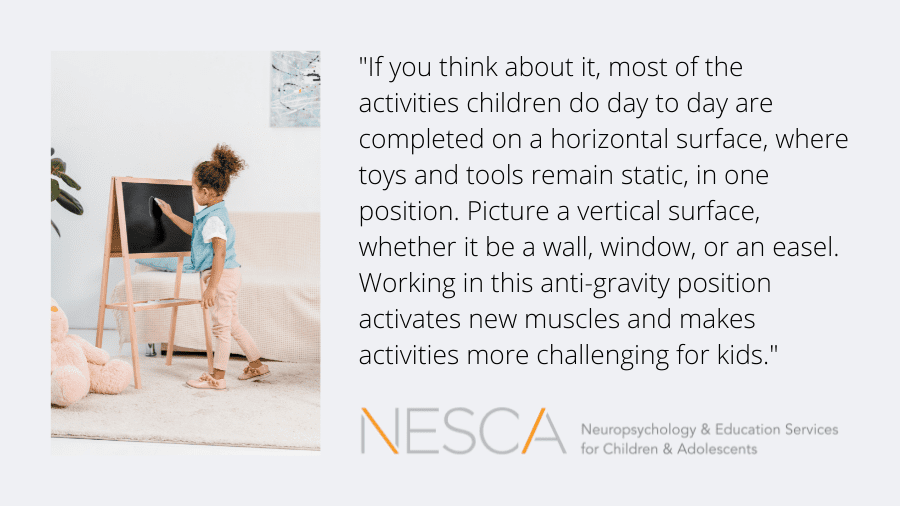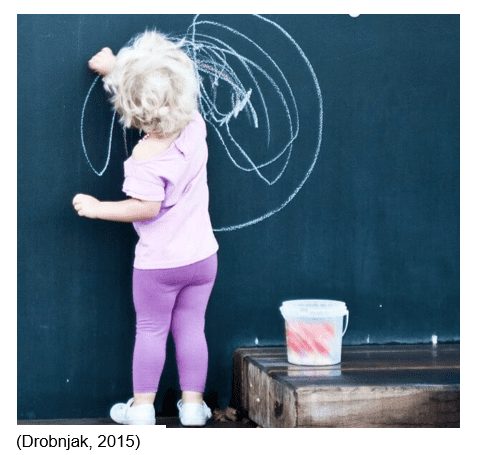
 By: Madelyn (Maddie) Girardi, OTD, OTR/L
By: Madelyn (Maddie) Girardi, OTD, OTR/L
Occupational Therapist, NESCA
What do you mean by a vertical surface?
If you think about it, most of the activities children do day to day are completed on a horizontal surface, where toys and tools remain static, in one position. Picture a vertical surface, whether it be a wall, window, or an easel. Working in this anti-gravity position activates new muscles and makes activities more challenging for kids. Think “tummy time,” but for our elementary-aged kids.
 What are the benefits of working on a vertical surface?
What are the benefits of working on a vertical surface?
- Shoulder, wrist, and elbow stability – These activities require a child to practice bigger arm movements that may not be utilized on a traditional, flat surface. These movements promote both strength and flexibility in the joints and muscles of the upper extremities.
- Core strength & postural control – If a child is completing vertical work in standing, he or she must reach outside of their base of support, activating those core muscles. Further increase the demands of the task by having the child complete the task in kneeling or while sitting on a therapy ball. This promotes balance and use of the stomach and leg muscles. Building this solid ‘core’ foundation is extremely important so that a child can develop more controlled movements in the upper extremities.
- Hand strength – Working against gravity requires a child to exert increased effort while building hand strength and endurance with a utensil.
- Visual spatial awareness & crossing midline – Working on a large vertical surface means more space to cover. This requires a child to visually scan a greater distance left to right, reaching across the imaginary “midline” of our body. Crossing midline is essential for developing bilateral coordination skills.
- Wrist extension for pencil grasp – This is a big one! Writing on a vertical surface naturally puts the wrist in extension, the ideal position for handwriting. In contrast, a flexed wrist limits finger mobility and control.
- Proprioception & force modulation – When performing a task on a vertical surface – think stickers or drawing – the child is required to practice grading movements so that he or she can apply the right amount of pressure for success (Boitano, 2020; Drobnjak, 2015).
What pediatric population benefits from this?
All kids would benefit from participating in these kinds of activities! Working on a vertical surface work can particularly help children to further develop the essential fine, visual, and gross motor skills. Sensory integration can also be targeted, as these kinds of activities allow a child to explore and develop proprioceptive, tactile, and visual processing skills.

Activities that can be done on a vertical or slanted surface (Boitano, 2020; Drobnjak, 2015)
- Writing
- Drawing/coloring
- Tracing (stencil) activities
- Stickers
- Painting (finger painting or with brush)
- Magnets
- Spray bottle activities
- Squigz or suction cup games
- Felt or Velcro boards
- Chalkboard, easel, or whiteboard activities
- Shaving cream
- LEGO wall
- Window or wall washing using sponge
Resources
Boitano, C. (2020, April 20). The benefits of writing and working on a vertical surface! OT Outside. Retrieved October 6, 2021 from https://www.otoutside.com/news/2020/4/19/the-benefits-of-writing-and-working-on-a-vertical-surface.
Drobnjak, L. (2015, June 27). Why Kids Should Work on a Vertical Surface. The Inspired Treehouse. Retrieved October 6, 2021 from https://theinspiredtreehouse.com/motor-skills-and-more-working-on-a-vertical-surface/
About the Author
Madelyn (Maddie) Girardi is a Licensed Occupational Therapist in Massachusetts with experience in both school-based and outpatient  pediatric settings. Maddie received her undergraduate degree in Exercise Science/Kinesiology at The College of Charleston in South Carolina and earned her Doctorate degree in Occupational Therapy from The MGH Institute of Health Professions in Boston.
pediatric settings. Maddie received her undergraduate degree in Exercise Science/Kinesiology at The College of Charleston in South Carolina and earned her Doctorate degree in Occupational Therapy from The MGH Institute of Health Professions in Boston.
Maddie is a passionate therapist with professional interest in working with young children with neurodevelopmental disorders, fine and gross motor delays and Autism Spectrum Disorder (ASD).
Neuropsychology & Education Services for Children & Adolescents (NESCA) is a pediatric neuropsychology practice and integrative treatment center with offices in Newton, Massachusetts, Plainville, Massachusetts, and Londonderry, New Hampshire, serving clients from preschool through young adulthood and their families. For more information, please email info@nesca-newton.com or call 617-658-9800.


 (Movement Matters, 2020).
(Movement Matters, 2020).
 Image Credit: (Miss Jamie O.T, 2021)
Image Credit: (Miss Jamie O.T, 2021)





Connect with Us